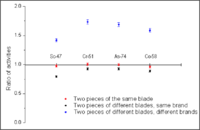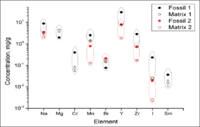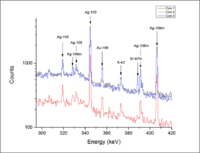ProposalDeepBlueMarine 2013
Project Summary
We propose to measure the concentrations of several nuclei using photon activation analysis (PAA) and determine if there is a correlation between several coin samples and candidate mines that may have been the source for the silver in the coin. Based on previous work (insert NAA reference) and our preliminary results, we intend to focus on Gold, Irridum, and Strontium nuclei. PAA has been able to measure the content of nuclei in a sample to the level of parts-per-million (PPM). PAA has successfully performed elemental and matching analyses for a wide variety of samples including museum artifacts [1], fossils [2], forensic samples [3], agricultural samples [4], and various environmental samples [5-6]. PAA is an ideal tool for performing the above measurements due to its ability to accurately measure PPM level concentrations without destroying the sample as compared to other methods of detecting base elements [7 - 9].
A Description of PAA
Previous results
PAA for Forensics
One of our latest projects performed a forensic analysis of several evidence samples from difference knives. We were investigating six samples: Sample 1 and Sample 2 were pieces of two identical knives of the same brand. Sample 3 and Sample 4 were pieces of a single knife. Sample 5 and Sample 6 were pieces of two knives from different manufacturers. All the samples had masses ranging from 2.5 to 4 grams and had approximately the same (but not identical) surface area. They were irradiated for 2 hours using a 30 MeV, 2 kW electron beam. Each samples's activity was measured after the irradiation using a high purity germanium detector. Several gamma emission lines, corresponding to Cr, Mo, Ni, Mn, Ti, Co, Sb, and As target nuclides, were easily identified. Figure 3 shows a comparison of the different element concentrations for the samples that were taken from one knife blade (red), from different blades of the same brand (black), and from different brands (blue). It’s clear that pieces of a particular knife blade can easily be differentiated. PAA can clearly distinguish between different batches of same-brand knives, and therefore can be an excellent evidence match analysis tool.
shall we include a statistical comparison
Provinence searches using PAA
Another recent project involved match analysis between the fossils and corresponding soil matrices. We simultaneously irradiated four samples collected from two separate locations in South Dakota - two of the samples were fossil bones and the other two samples were the rock matrices. 20 MeV electron accelerator was used to produce bremsstrahlung photons. After 5 hours of irradiation we measured gamma-activity of the samples. From which we estimated the concentration of different elements in the fossils and in the matrices (Figure 4). There is a strong correlation between two pairs of samples and elemental composition. First, some elements were only detected in one set of samples. For example, Mg, Cr, and Sm was present in both fossil and matrix belonging to the first set, but could not be detected in the second set. Some elements are present in all four samples, but their concentration correlates with the set directly. In particular, first set has higher concentration of Na, Mn, Y, Zr, and I. Second set, on the other hand, has higher composition of Br. Thus we were able to show that there is a strong correlation between the elemental composition of the fossil and the elemental composition of the corresponding matrix.
Preliminary results
In March of 2013, three silver coins were provided by Deep Blue Marine to measure the spectrum of photon energies emitted by irradiated coins. These measurements were the first step towards using PAA to perform a multivariate statistical analysis that can test the origin of the coins.
Proposed Work
We are proposing to perform the following tasks:
1) Estimation of photon flux and prediction of activities
After the number of samples, their shape and mass is known, Monte-Carlo simulations will be performed to estimate photon flux through the samples and choose an optimum irradiation conditions, such as:
- positioning of the samples - time of irradiation - electron beam parameters, such as electron energy and average current
The simulations will be performed using special radiation transport software, MCNP, at the Idaho Accelerator Center computer cluster (12 nodes, 52 cores, 64GB of aggregate memory, and 108GHz of aggregate CPU power).
2) Sample irradiation and gamma-spectrometry
Once the irradiation conditions are established, samples (artifacts and ores) will be irradiated for a short time (10-30 minutes) for two purposes: do qualitative analysis of elemental composition and verify the predictions of photon flux and activities. After making sure the activities correspond to the predicted values the samples, together with the reference material, will be irradiated for 8-10 hours to maximize the sensitivity of the technique and minimize the detection limit. After irradiation, the samples’ elemental composition will be measured using high purity germanium detector. All the spectra will be stored.
3) Data analysis
Gamma spectra will be analyzed using Gamma-W software. Peaks in the spectra will be identified and concentration of each element will be calculated from the produced radioactivity. 4) Final report
All the activities will be described in details. We will provide the description of the experiment, raw spectroscopic data and a table of calculated concentrations of different elements. Error analysis will be performed and uncertainties will be included. The work undertaken as part of this proposal will be completed by May 1, 2013.
Bibliography
[1] C. Segebade, “Investigation of a medieval sword using photon activation analysis”, Journal of Radioanalytical and Nuclear Chemistry, 169, 1, pp 27-37, 1993 [2] V. Starovoitova, P. Cole, C. Segebade, “Multi-element photon activation analysis of fossil samples”, 2013 (in preparation)
[3] V. Starovoitova, P. Cole, C. Segebade, “Forensic evidence sample matching using photon activation analysis”, 2013 (in preparation)
[4] Z. J. Sun, D. P. Wells, C. Segebade, H. Maschner, B. Benson, “A provenance study of coffee by photon activation analysis”, Journal of Radioanalytical and Nuclear Chemistry, in print, 2012
[5] Mamtimin M, Cole P, Segebade C. “Photon activation analysis of dust particles for environmental research and applications using the 44 MeV electron LINAC at the Idaho accelerator center”, AccApp ‘11—tenth international topical meeting on nuclear applications of accelerators, Knoxville, TN [6] Thümmel HW, Segebade C, Hirsch K., “Optimization of irradiation conditions for photon activation analysis of biological and environmental samples using a high power electron accelerator”, Biol Trace Elem Res., 43-45:141-9, 1994 [7] Segebade C, Weise HP, Lutz GJ (1987) Photon activation analysis. W. de Gruyter, Berlin
[8] Segebade, C., A Schmitt, B.F., “Analysis of high-purity material—A comparison of photon activation analysis with other instrumental methods”, Journal of Radioanalytical and Nuclear Chemistry. 113, 1, pp 61-76, 1983
[9] Neider, R., Dudzus, Th., Fusban, H.U., Jost, P., Reimers, P., Schmitt, B.F., Segebade, Chr., Wandelburg, K., Weise, H.P., “Comparison of photon activation analysis with other modern analytical methods as tools for the solution of actual analytical problems”, Journal of Radioanalytical and Nuclear Chemistry, 39, 1-2, pp 397-408, 1977


